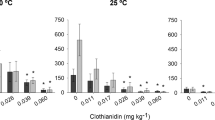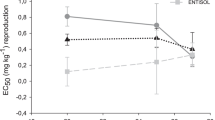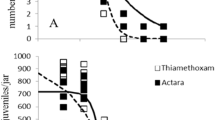Abstract
Purpose
Ecotoxicological risk assessment of chemical compounds is considered more accurate when mixtures of chemicals and/or interactions between chemicals and natural stressors are considered. To further simulate natural conditions, under which organisms are often exposed to combinations of natural and anthropogenic stressors, the combined exposure of a widely used insecticide, carbaryl, under UV radiation was evaluated. It is more than likely that soil organisms are confronted with a combination of chemical exposure and increasing UV irradiance on the terrestrial habitat. Considering the heterogeneity of contamination in field soils and the probability of collembolan to avoid contaminated soil (less time under exposure), combined effects of carbaryl and ultraviolet radiation were evaluated, by using a short exposure to Folsomia candida.
Materials and methods
Single exposures to carbaryl and UV radiation were performed, and adult mortality and number of laid and hatched eggs were reported. Following the results, a combined exposure was carried out, using the same conditions performed previously in the single tests. Organisms were exposed simultaneously to carbaryl (from 1 to 7 mg kg−1) and UV doses (from 1,121.29 to 3,795.26 J m−2), the last corresponds to 1 to 4 h of exposure. Mortality was reported, and organisms were left to lay eggs in culture boxes.
Results and discussion
Both ultraviolet radiation and high concentrations of carbaryl as single stressors increased the number of produced eggs of F. candida, with significant differences at higher concentrations (4, 5.5, and 7 mg kg−1) of carbaryl and an EC50 of 5.93 mg kg−1. In the case of UV radiation, statistical differences were found at all concentrations compared with control, with an EC50 of 1,248.24 J m−2. In both cases, no significant mortality was observed. When combined, both stressors acted independently on egg production, showing additivity of effects (independent action (IA) model to data on laid eggs; SS = 0.00056; r2 = 0.75; p < 0.05).
Conclusions
This study highlights the importance of taking UV exposure conditions into account when assessing the impact of pesticides to soil biota and looking for more realistic scenarios while showing that soil sheltering occurs only up to a certain extent and that indirect effects can be observed. The opposite trends on responses obtained under standardized tests and short exposures to carbaryl provided some insight on the possible effects of carbaryl during collembolan life cycle.



Similar content being viewed by others
References
Backhaus T, Altenburger R, Arrhenius Å, Blanck H, Faust M, Finizio A, Gramatica P, Grote M, Junghans M, Meyer W, Pavan M, Porsbring T, Scholze M, Todeschini R, Vighi M, Walter H, Horst Grimme L (2003) The BEAM-project: prediction and assessment of mixture toxicities in the aquatic environment. Cont Shelf Res 23:1757–1769
Beresford GW, Selby G, Moore JC (2013) Lethal and sub-lethal effects of UV-B radiation exposure on the collembolan Folsomia candida (Willem) in the laboratory. Pedobiologia 56:89–95
Bischof K, Gómez I, Molis M, Hanelt D, Karsten U, Lüder U, Roleda MY, Zacher K, Wiencke C (2007) Ultraviolet radiation shapes seaweed communities. In: Amils R, Ellis-Evans C, Hinghofer-Szalkay H (eds) Life in Extreme Environments. Springer, The Netherlands, pp 187–212
Caldwell MM, Björn LO, Bornman JF, Flint SD, Kulandaivel G, Teramura AH, Tevini M (1998) Effects of increased solar ultraviolet radiation on terrestrial ecosystems. JPP B Biol 46:40–52
Chuang S-C, Lai WS, Chen JH (2006) Influence of ultraviolet radiation on selected physiological responses of earthworms. J Exp Biol 209:4304–4312
Fischer JM, Fields PA, Pryzbylkowski PG, Nicolai JL, Neale PJ (2006) Sublethal exposure to UV radiation affects respiration rates of the freshwater cladoceran Daphnia cafawba. Photochem Photobiol 82:547–550
Fountain MT, Hopkin SP (2005) Folsomia candida (Collembola): a “standard” soil arthropod. Ann Rev Entomol 50:201–222
Gambi N, Pasteris A, Fabbri E (2007) Acetylcholinesterase activity in the earthworm Eisenia andrei at different conditions of carbaryl exposure. Comp Biochem Physiol C Toxicol Pharmacol 145:678–685
Gupta SK, Saxena PN (2003) Carbaryl-induced behavioural and reproductive abnormalities in the earthworm Metaphire posthuma: a sensitive model. Altern Lab Anim ATLA 31:587
Hatch AC, Blaustein AR (2003) Combined effects of UV-B radiation and nitrate fertilizer on larval amphibians. Ecol Appl 13:1083–1093
Holmstrup M, Bindesbøl AM, Oostingh GJ, Duschl A, Scheil V, Köhler HR, Loureiro S, Soares AMVM, Ferreira ALG, Kienle C, Gerhardt A, Laskowski R, Kramarz PE, Bayley M, Svendsen C, Spurgeon DJ (2010) Interactions between effects of environmental chemicals and natural stressors: a review. Sci Total Environ 408:3746–3762
ISO (1999) Soil quality – inhibition of reproduction of Collembola (Folsomia candida) by soil pollutants. ISO/DIS 22030, Geneva, Switzerland
Jeffery S, Gardi C, Jones A, Montanarella L, Marmo L, Miko L, Ritz K, Peres G, Römbke J, Van der Putten W (2010) European atlas of soil biodiversity. European Commission
Jonker MJ, Svendsen C, Bedaux JJM, Bongers M, Kammenga JE (2005) Significance testing of synergistic/antagonistic, dose level-dependent, or dose ratio-dependent effects in mixture dose-response analysis. Environ Toxicol Chem 24:2701–2713
Karanas JJ, Worrest RC, Dyke H (1981) Impact of UV-B radiation on the fecundity of the copepod Acartia clausii. Mar Biol 65:125–133
Kovaleva E, Talanov G (1978) Residual amounts of Sevin in plants and soil. Khim Sel'sk Khoz 16(8)
Kuribayashi S (1981) Studies on the effect of pesticides on the reproduction of the silkworm, Bombyx mori LI effects of chemicals administered during the larval stage on egg-laying and hatching. J Toxicol Sci 6:169
Laskowski R (2001) Why short-term bioassays are not meaningful—effects of a pesticide (imidacloprid) and a metal (cadmium) on pea aphids (Acyrthosiphon pisum Harris). Ecotoxicology 10:177–183
Laskowski R, Bednarska AJ, Kramarz PE, Loureiro S, Scheil V, Kudłek J, Holmstrup M (2010) Interactions between toxic chemicals and natural environmental factors—a meta-analysis and case studies. Sci Total Environ 408:3763–3774
Lavola ANU, Julkunen-Tiitto R, Aphalo P, De La Rosa T, Lehto T (1997) The effect of u.v.-B radiation on u.v.-absorbing secondary metabolites in birch seedlings grown under simulated forest soil conditions. New Phytol 137:617–621
Lima MP, Cardoso DN, Soares AM, Loureiro S (2014) Carbaryl toxicity prediction to soil organisms under high and low temperature regimes. Ecotoxicol Environ Saf. doi:10.1016/j.ecoenv.2014.04.004
Lima MP, Soares AM, Loureiro S (2011) Combined effects of soil moisture and carbaryl to earthworms and plants: simulation of flood and drought scenarios. Environ Pollut 159:1844–1851
Loureiro S, Amorim MJB, Campos B, Rodrigues SMG, Soares AMVM (2009) Assessing joint toxicity of chemicals in Enchytraeus albidus (Enchytraeidae) and Porcellionides pruinosus (Isopoda) using avoidance behaviour as an endpoint. Environ Pollut 157:625–636
MacArthur RH (1967) The theory of island biogeography. Princeton University Press
McMichael AJ (2003) Climate change and human health: risks and responses. WHO
Misra RB, Lal K, Farooq M, Hans RK (2005) Effect of solar UV radiation on earthworm (Metaphire posthuma). Ecotoxicol Environ Saf 62:391–396
Morgado R, Ferreira NGC, Tourinho P, Ribeiro F, Soares AMVM, Loureiro S (2013) Environmental- and growth stage-related differences in the susceptibility of terrestrial isopods to UV radiation. J Photochem Photobiol B Biol 126:60–71
OECD (2009) Test No. 232: Collembolan reproduction test in soil. OECD Publishing
Paul ND, Gwynn-Jones D (2003) Ecological roles of solar UV radiation: towards an integrated approach. Trends Ecol Evol 18:48–55
Pestana JLT, Loureiro S, Baird DJ, Soares AMVM (2010) Pesticide exposure and inducible antipredator responses in the zooplankton grazer, Daphnia magna Straus. Chemosphere 78(3):241–248
Rautio M, Tartarotti B (2010) UV radiation and freshwater zooplankton: damage, protection and recovery. Freshwat Rev J Freshwat Biol Assoc 3:105
Relyea RA, Mills N (2001) Predator-induced stress makes the pesticide carbaryl more deadly to gray treefrog tadpoles (Hyla versicolor). Proc Natl Acad Sci 98:2491–2496
Ribeiro F, Ferreira NCG, Ferreira A, Soares AMVM, Loureiro S (2011) Is ultraviolet radiation a synergistic stressor in combined exposures? The case study of Daphnia magna exposure to UV and carbendazim. Aquat Toxicol 102:114–122
Rozema J, Björn LO, Bornman JF, Gaberščik A, Häder DP, Trošt T, Germ M, Klisch M, Gröniger A, Sinha RP, Lebert M, He YY, Buffoni-Hall R, de Bakker NVJ, van de Staaij J, Meijkamp BB (2002) The role of UV-B radiation in aquatic and terrestrial ecosystems—an experimental and functional analysis of the evolution of UV-absorbing compounds. J Photochem Photobiol B Biol 66:2–12
Santos MJG, Soares AMVM, Loureiro S (2010) Joint effects of three plant protection products to the terrestrial isopod Porcellionides pruinosus and the collembolan Folsomia candida. Chemosphere 80(9):1021–1030
Simpson W, Von Glasow R, Riedel K, Anderson P, Ariya P, Bottenheim J, Burrows J, Carpenter L, Frieß U, Goodsite M (2007) Halogens and their role in polar boundary-layer ozone depletion. Atmos Chem Phys 7:4285–4403
Sinha RP, Häder D-P (2002) UV-induced DNA damage and repair: a review. Photochem Photobiol Sci 1:225–236
Tsogas GZ, Giokas DL, Nikolakopoulos PG, Vlessidis AG, Evmiridis NP (2006) Determination of the pesticide carbaryl and its photodegradation kinetics in natural waters by flow injection–direct chemiluminescence detection. Anal Chim Acta 573–574:354–359
TEMIS- Tropospheric Emission Monitoring Internet Service (2013) UV index & UV dose based on GOME. Retrieved 28 June 2013, from http://www.temis.nl/uvradiation/GOME/overview.php?fl=Angra_do_Heroismo.inc
WHO (1994) Environmental Health Criteria 153. Geneva
Xu J, Wang Y, Luo YM, Song J, Ke X (2009) Effects of copper, lead and zinc in soil on egg development and hatching of Folsomia candida. Insect Sci 16:51–55
Acknowledgements
This study was supported by FEDER through COMPETE e Programa Operacional Fatores de Competitividade and by National funding through Fundação para a Ciência e Tecnologia (FCT), within the research project CLIMAFUN—Climate Changes and Potential Impact on Soil Functional Ecology (FCOMP-01-0124-FEDER-008656; Ref. PTDC/AAC-CLI/104960/2008). Amadeu MVM Soares is “Bolsista CAPES/BRASIL”, Project NºA058/2013.
Author information
Authors and Affiliations
Corresponding author
Additional information
Responsible editor: Dong-Mei Zhou
Electronic supplementary material
Below is the link to the electronic supplementary material.
ESM 1
(DOCX 18 kb)
Rights and permissions
About this article
Cite this article
Cardoso, D.F.N., Bastos, A.C., Soares, A.M.V.M. et al. Short-term exposure to carbaryl and UV radiation increases the reproduction output of the collembolan Folsomia candida . J Soils Sediments 14, 1559–1567 (2014). https://doi.org/10.1007/s11368-014-0892-6
Received:
Accepted:
Published:
Issue Date:
DOI: https://doi.org/10.1007/s11368-014-0892-6




